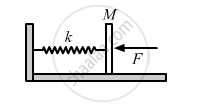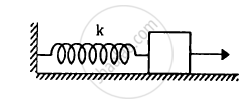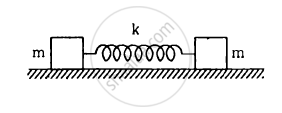Advertisements
Advertisements
प्रश्न
In following figure k = 100 N/m M = 1 kg and F = 10 N.
- Find the compression of the spring in the equilibrium position.
- A sharp blow by some external agent imparts a speed of 2 m/s to the block towards left. Find the sum of the potential energy of the spring and the kinetic energy of the block at this instant.
- Find the time period of the resulting simple harmonic motion.
- Find the amplitude.
- Write the potential energy of the spring when the block is at the left extreme.
- Write the potential energy of the spring when the block is at the right extreme.
The answer of b, e and f are different. Explain why this does not violate the principle of conservation of energy.

उत्तर
It is given that :
Spring constant, k = 100 N/m,
Mass of the block, M = 1 kg
Force, F = 10 N

(a) In the equilibrium position,
F = kx
where x is the compression of the spring, and
k is the spring constant.
∴ `x = F/k = 10/100`
= 0.1 m = 10 cm
(b) The blow imparts a speed of 2 ms-1 to the block, towards left.
Potential energy of spring, U = `1/2 kx^2`
Kinetic energy,
`K = 1/2 mv^2`
(c) Time period (T) is given by,
`T = 2pisqrt(M/k)`
`2pi sqrt(1/100) = pi/5` s
(d) Let A be the amplitude.
Amplitude is the distance between the mean and the extreme position.
At the extreme position, the compression of the spring will be (A + x).
As the total energy in S.H.M. remains constant, we can write:
`1/2k(A + x )^2 = 1/2kx^2 + 1/2Mv^2 + FA`
= 2.5 + 10A
∴ 50(A + 0.1)2 = 2.5 + 10A
⇒ 50A2 + 0.5 + 10A = 2.5 + 10A
⇒ 50A2 = 2
⇒ `A^2 = 2/50 = 4/100`
⇒ `A = 2/10 m = 0.2 m = 20 cm`
(e) Potential Energy at the left extreme will be,
`P.E. = 1/2k(A + x)^2`
= `1/2 xx 100 xx (0.1 + 0.2)^2`
= 50 × (0.09) = 4.5 J
(f) Potential Energy at the right extreme is calculated as:
Distance between the two extremes = 2A
`P.E. = 1/2k(A + x)^2 - F(2A)`
= 4.5 − 10(0.4) = 0.5 J
As the work is done by the external force of 10 N, different values of options (b), (e), and (f) do not violate the law of conservation of energy.
APPEARS IN
संबंधित प्रश्न
A particle executes simple harmonic motion with an amplitude of 10 cm. At what distance from the mean position are the kinetic and potential energies equal?
The maximum speed and acceleration of a particle executing simple harmonic motion are 10 cm/s and 50 cm/s2. Find the position(s) of the particle when the speed is 8 cm/s.
A particle having mass 10 g oscillates according to the equation x = (2.0 cm) sin [(100 s−1)t + π/6]. Find (a) the amplitude, the time period and the spring constant. (c) the position, the velocity and the acceleration at t = 0.
The equation of motion of a particle started at t = 0 is given by x = 5 sin (20t + π/3), where x is in centimetre and t in second. When does the particle
(a) first come to rest
(b) first have zero acceleration
(c) first have maximum speed?
The pendulum of a clock is replaced by a spring-mass system with the spring having spring constant 0.1 N/m. What mass should be attached to the spring?
A body of mass 2 kg suspended through a vertical spring executes simple harmonic motion of period 4 s. If the oscillations are stopped and the body hangs in equilibrium find the potential energy stored in the spring.
The spring shown in figure is unstretched when a man starts pulling on the cord. The mass of the block is M. If the man exerts a constant force F, find (a) the amplitude and the time period of the motion of the block, (b) the energy stored in the spring when the block passes through the equilibrium position and (c) the kinetic energy of the block at this position.

Repeat the previous exercise if the angle between each pair of springs is 120° initially.
Consider the situation shown in figure . Show that if the blocks are displaced slightly in opposite direction and released, they will execute simple harmonic motion. Calculate the time period.

Show that for a particle executing simple harmonic motion.
- the average value of kinetic energy is equal to the average value of potential energy.
- average potential energy = average kinetic energy = `1/2` (total energy)
Hint: average kinetic energy = <kinetic energy> = `1/"T" int_0^"T" ("Kinetic energy") "dt"` and
average potential energy = <potential energy> = `1/"T" int_0^"T" ("Potential energy") "dt"`
A body is executing simple harmonic motion with frequency ‘n’, the frequency of its potential energy is ______.
A body is executing simple harmonic motion with frequency ‘n’, the frequency of its potential energy is ______.
A body is executing simple harmonic motion with frequency ‘n’, the frequency of its potential energy is ______.
Motion of an oscillating liquid column in a U-tube is ______.
A body is performing S.H.M. Then its ______.
- average total energy per cycle is equal to its maximum kinetic energy.
- average kinetic energy per cycle is equal to half of its maximum kinetic energy.
- mean velocity over a complete cycle is equal to `2/π` times of its π maximum velocity.
- root mean square velocity is times of its maximum velocity `1/sqrt(2)`.
A mass of 2 kg is attached to the spring of spring constant 50 Nm–1. The block is pulled to a distance of 5 cm from its equilibrium position at x = 0 on a horizontal frictionless surface from rest at t = 0. Write the expression for its displacement at anytime t.
An object of mass 0.5 kg is executing a simple Harmonic motion. Its amplitude is 5 cm and the time period (T) is 0.2 s. What will be the potential energy of the object at an instant t = `T/4` s starting from the mean position? Assume that the initial phase of the oscillation is zero.
A particle undergoing simple harmonic motion has time dependent displacement given by x(t) = A sin`(pit)/90`. The ratio of kinetic to the potential energy of this particle at t = 210s will be ______.
The total energy of a particle, executing simple harmonic motion is ______.
where x is the displacement from the mean position, hence total energy is independent of x.
